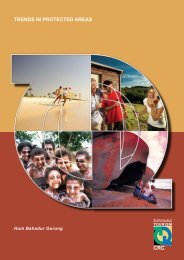icolls - Sustainable Tourism CRC
icolls - Sustainable Tourism CRC
icolls - Sustainable Tourism CRC
Create successful ePaper yourself
Turn your PDF publications into a flip-book with our unique Google optimized e-Paper software.
ECOLOGY, THREATS AND MANAGEMENT OPTIONS FOR SMALL ESTUARIES AND ICOLLS<br />
For A. australis individuals there was general agreement between the contributions of prey items to<br />
individual diets (Figure 6). However, mixing model analyses indicated that a greater contribution from teleost<br />
fish was to be expected on the basis of muscle carbon and nitrogen signatures (Figure 6). Furthermore,<br />
difficulties associated with identification of prey items in some guts (high miscellaneous contribution in Figure<br />
6) makes comparisons between these two methods difficult.<br />
Figure 6: Comparison of gut contents and stable isotope analyses of percent contribution of prey types to<br />
the diet of A. australis individuals in Belongil Creek<br />
Given that the diet of M. cephalus is generally dominated by miscellaneous detritus and particulate matter<br />
(Table 9 and 10) and that similar catch sizes were recorded in Belongil and Tallows Creeks (Table 8), we used<br />
mixing model reconstructions of dietary compositions from primary carbon sources to compare the basis of M.<br />
cephalus nutrition in the two sites. Whilst epilithon contributed almost 100% of the carbon and nitrogen in M.<br />
cephalus muscles in Belongil Creek, equivalent contributions were made from epilithon, seston and riparian<br />
vegetation in Tallows Creek (Figure 7).<br />
42<br />
100%<br />
80%<br />
60%<br />
40%<br />
20%<br />
0%<br />
100%<br />
80%<br />
60%<br />
40%<br />
20%<br />
0%<br />
Gut Contents Mixing Model<br />
Tallows Belongil<br />
Gastropods<br />
Polychaetes<br />
Decapods<br />
Figure 7: Mixing model analyses of sources of carbon contributing to M. cephalus diets from individuals<br />
caught in Tallows (n=12) and Belongil (n=13) Creeks<br />
Stable isotope analyses revealed that S. ciliata individuals fed on a broader range of prey taxa than was<br />
revealed on the basis of gut contents analyses (Figure 8). While the guts of many individuals were full of<br />
polychaete worms (Table 9 and 10), isotope data indicates that these prey items had contributed only a small<br />
proportion of the dietary carbon and nitrogen in their muscle tissues. Other teleost fish, decapod crustaceans and<br />
gastropod molluscs also contributed to S. ciliata diets despite the low abundance or complete absence from the<br />
guts of individuals in both sites.<br />
Fish<br />
Epilithon<br />
Seston<br />
Miscellaneous<br />
Riparian Vegetation











